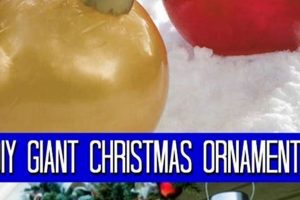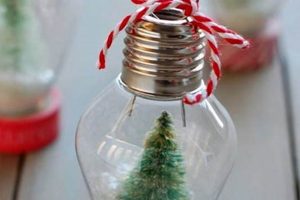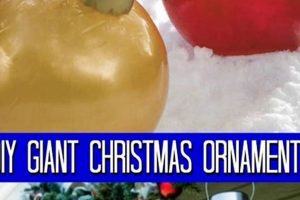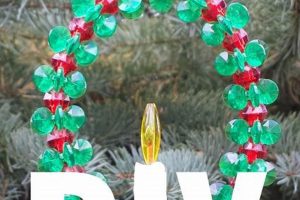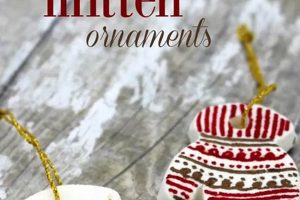Crafting decorative spheres or similar shapes using velvet fabric through do-it-yourself methods constitutes a specific form of holiday decoration. These handmade items, often adorned with embellishments such as beads, ribbons, or embroidery, serve as personalized additions to festive displays.
The creation of these objects offers an avenue for individual expression and creativity. The tactile nature of the materials and the inherent customization possibilities can result in unique and cherished family heirlooms. Historically, handcrafted decorations have represented a move away from mass-produced items, emphasizing the value of artisanal skills and personal touch during celebratory seasons.
The following sections will explore various techniques for producing such decorations, providing detailed instructions on material selection, construction methods, and embellishment options. The aim is to equip readers with the knowledge and skills to confidently embark on this crafting endeavor.
Tips for Creating Velvet Decorations
Achieving optimal results when constructing velvet decorations necessitates careful attention to detail. The following tips are designed to guide the crafting process and enhance the final product.
Tip 1: Fabric Selection: Opt for high-quality velvet. Lower-grade velvets may exhibit excessive shedding or an uneven nap, compromising the final appearance. Consider the weight of the fabric; heavier velvets often provide a more luxurious feel and hold their shape better.
Tip 2: Pattern Precision: Precise pattern cutting is crucial. Use sharp scissors or a rotary cutter to ensure clean edges, minimizing fraying and facilitating smooth seams. When using a template, trace it carefully onto the fabric, accounting for seam allowances.
Tip 3: Stitching Techniques: Utilize appropriate stitching techniques to secure seams. A short stitch length on a sewing machine, or a secure backstitch when hand-sewing, will prevent seams from unraveling, particularly on fabrics prone to slipping.
Tip 4: Stuffing Considerations: Select appropriate stuffing materials. Fiberfill is a common choice, offering a soft and even fill. However, consider using weighted stuffing materials like rice or dried beans for added stability, particularly in larger designs.
Tip 5: Embellishment Adhesion: When attaching embellishments, employ suitable adhesives. Hot glue is effective for securing larger elements, while fabric glue is recommended for delicate items. Ensure the adhesive is compatible with both the velvet and the embellishment to prevent discoloration or detachment.
Tip 6: Preventing Velvet Crushing: Velvet is susceptible to crushing. To prevent unwanted marks, avoid excessive pressure during construction. When pressing seams, use a pressing cloth and low heat. Consider steaming instead of ironing to restore the velvet’s nap.
Tip 7: Securing Ribbons and Loops: Reinforce ribbon loops or hanging mechanisms securely. Use multiple stitches or knotting techniques to ensure the decoration remains securely attached, particularly when suspending heavier pieces.
Adhering to these guidelines will contribute significantly to the creation of visually appealing and structurally sound decorative velvet items, increasing their longevity and aesthetic appeal.
With these tips in mind, the reader is well-prepared to advance to exploring specific project ideas and advanced techniques.
1. Velvet quality.
The selection of velvet material directly influences the appearance, durability, and overall aesthetic of handcrafted decorative spheres or similar shapes. The inherent characteristics of the fabric determine the ease with which the ornament can be constructed and its long-term resilience. For example, a high-quality velvet will exhibit a dense pile, resisting crushing and maintaining its rich color over time, directly enhancing the ornament’s visual appeal. Conversely, inferior velvet grades may feature sparse piles, resulting in a lackluster appearance and increased susceptibility to wear and tear. The texture of the velvet also affects how embellishments adhere, with smoother, denser velvets providing a more stable surface for beads, ribbons, or embroidery.
The practical significance of prioritizing superior velvet becomes evident when considering the labor investment involved in creating these decorations. The time spent crafting a decorative item is better allocated to materials that will endure and maintain their appearance over successive years. Lower-quality velvets may necessitate frequent repairs or replacements, negating any initial cost savings. In contrast, ornaments crafted from high-grade velvet become cherished family heirlooms, capable of withstanding the rigors of annual use and storage. Furthermore, the drape and handling properties of the fabric influence the ease with which the ornament can be shaped and assembled. Finer velvets tend to mold more readily to desired forms, resulting in a neater, more professional finished product.
In summary, velvet quality is not merely a superficial consideration; it is a fundamental determinant of the decorative object’s success. While budgetary constraints may influence material choices, understanding the long-term benefits associated with superior velvet can justify the investment, leading to more aesthetically pleasing, durable, and ultimately, more valued handcrafted decorations. Overlooking this key element can diminish the impact and longevity of the final product.
2. Construction technique.
The method employed to assemble decorative velvet spheres directly affects their structural integrity and visual appeal. A flawed construction technique can lead to seam failures, uneven stuffing distribution, and a compromised overall shape, diminishing the value and aesthetic of the finished object. Conversely, careful attention to the chosen construction method ensures a durable and visually pleasing result. For instance, hand-sewing techniques such as the ladder stitch can create virtually invisible seams, while machine stitching provides greater speed and strength, particularly for larger or more complex designs. The selection of an appropriate construction technique is contingent on factors such as the crafter’s skill level, the complexity of the design, and the desired level of durability.
One common approach involves creating a pattern, cutting multiple velvet pieces based on that pattern, and then sewing these pieces together, leaving a small opening for stuffing. The opening is then closed with careful stitches. Another technique utilizes a pre-made foam or plastic sphere as a base, covering it with velvet fabric that is glued or sewn into place. The choice between these and other methods impacts the final product’s appearance and longevity. Improper stuffing techniques, such as overstuffing or uneven distribution, can distort the sphere’s shape and create unsightly bulges. Similarly, inadequate seam reinforcement can lead to fabric separation over time. The use of interfacing can provide added structure and prevent stretching, particularly when working with delicate velvets. Precision in each step of the construction process is paramount for achieving a professional-looking outcome.
In summary, the construction technique is not a mere procedural detail but a fundamental element that determines the success of decorative velvet object creation. A thorough understanding of various stitching methods, stuffing techniques, and pattern-making principles is essential for crafting visually appealing and structurally sound decorations. Neglecting this aspect can result in a product that falls short of its potential, compromising both its aesthetic value and its longevity as a cherished decorative item. The careful selection and execution of an appropriate construction technique is, therefore, a critical investment in the crafting process.
3. Embellishment selection.
The strategic selection of embellishments is intrinsically linked to the overall success of decorative velvet creations. Embellishments, encompassing items such as beads, ribbons, sequins, and embroidery, serve as the primary mechanism for individualizing and elevating the aesthetic value of velvet objects. A poorly chosen embellishment can detract from the velvet’s inherent beauty, while a thoughtfully selected one can enhance its texture, color, and overall design. The cause-and-effect relationship is direct: deliberate embellishment choices lead to visually captivating outcomes, whereas haphazard selections result in a diminished final product. For instance, the addition of delicate pearl beads can impart a sense of elegance and sophistication, while the use of coarse, mismatched sequins can appear gaudy and detract from the velvet’s inherent luxury. The importance of embellishment selection is underscored by its ability to transform a simple velvet form into a unique and personalized work of art.
Real-life examples demonstrate the practical significance of understanding this connection. Consider a simple sphere covered in deep red velvet. This sphere, while visually appealing in its simplicity, gains significant dimension with the addition of gold-toned embroidery outlining a delicate floral pattern. This embellishment complements the rich color of the velvet and enhances its texture, creating a more visually compelling object. Conversely, if the same sphere were adorned with large, plastic gems in clashing colors, the effect would be jarring and the velvet’s inherent elegance would be lost. The selection of thread colors for embroidery, the size and shape of beads, and the texture and pattern of ribbons all play a crucial role in the final aesthetic. A cohesive theme, reflecting a particular style or holiday tradition, is often achieved through deliberate embellishment choices.
In conclusion, the mindful selection of embellishments is a critical component of crafting aesthetically pleasing decorative velvet objects. It requires a nuanced understanding of color theory, texture, and design principles. The challenges lie in achieving a harmonious balance between the inherent qualities of the velvet and the added embellishments. Ultimately, the ability to skillfully integrate embellishments transforms a basic velvet form into a personalized and visually striking work of art, elevating its value and appeal as a cherished decorative item.
4. Shape integrity.
Shape integrity, in the context of handcrafted velvet ornaments, is the capacity of the finished piece to maintain its intended form throughout its lifespan. The relationship between shape integrity and velvet ornaments is one of direct consequence: poor shape integrity results in a visually unappealing or structurally unsound ornament, while robust shape integrity yields a lasting and aesthetically pleasing decorative item. Shape distortion can arise from a multitude of factors, including inadequate fabric selection, improper stuffing techniques, or poorly executed construction methods. The result is an ornament that appears misshapen, uneven, or prone to collapsing under its own weight. Therefore, the maintenance of shape integrity is paramount to the success of velvet ornament projects.
The selection of appropriate materials significantly influences shape retention. A high-quality velvet with a dense pile, coupled with a robust internal structure provided by materials such as tightly packed fiberfill or strategically placed interfacing, contributes directly to the ornament’s ability to maintain its form. Real-world examples demonstrate this principle: ornaments constructed with inexpensive, loosely woven velvet and sparsely filled with low-density stuffing tend to lose their shape quickly, often appearing deflated or lopsided after only a short period of use. Conversely, ornaments made with durable velvet, reinforced seams, and firmly packed stuffing retain their intended shape for years, becoming cherished decorative items passed down through generations. The impact of shape integrity extends beyond mere aesthetics; it also affects the ornament’s functionality. A distorted or collapsing ornament may be difficult to hang properly, diminishing its decorative value.
In conclusion, shape integrity is a critical determinant of the quality and longevity of decorative velvet ornaments. Achieving optimal shape integrity necessitates careful attention to material selection, construction methods, and stuffing techniques. The resulting ornament is not only visually appealing but also structurally sound, capable of withstanding the rigors of annual use and storage. The challenges involved in maintaining shape integrity highlight the importance of skilled craftsmanship and a thorough understanding of the materials and techniques employed in velvet ornament creation. Overcoming these challenges leads to the creation of truly lasting and valued decorative items.
5. Hanging mechanism.
The method by which a decorative velvet creation is suspended, commonly referred to as the hanging mechanism, is an indispensable element of its design and functionality. The success of a handcrafted velvet item as a decorative object hinges significantly on the integrity and aesthetic suitability of its hanging mechanism. The following outlines key facets of consideration when integrating a hanging mechanism into such projects.
- Loop Security
A primary consideration is the secure attachment of the hanging loop. The selected material, whether ribbon, cord, or wire, must be robust enough to support the ornament’s weight without risk of detachment. Real-world scenarios demonstrate that poorly secured loops lead to ornaments falling and potentially sustaining damage. For instance, a velvet ornament adorned with delicate beads, if equipped with a flimsy loop, could detach and shatter upon impact. This underscores the importance of reinforced stitching or adhesive techniques when affixing the loop to the velvet.
- Material Compatibility
The hanging mechanism material must be compatible with the velvet fabric. Incompatible materials can result in discoloration, degradation, or structural weakness. An example of incompatibility would be using a wire loop that corrodes over time, staining the surrounding velvet fabric and weakening the attachment point. Conversely, a velvet ribbon loop complements the fabric and provides a secure and aesthetically pleasing solution.
- Aesthetic Integration
The hanging mechanism should seamlessly integrate with the overall aesthetic of the ornament. An ill-suited mechanism can detract from the ornament’s visual appeal, negating the effort invested in the velvet’s construction and embellishment. As an illustration, a rustic, twine loop may complement a homespun velvet ornament, while a sleek, metallic loop would better suit a modern, minimalist design. Careful consideration must be given to the color, texture, and style of the hanging mechanism to ensure it enhances rather than diminishes the ornament’s beauty.
- Weight Distribution
The hanging mechanism’s placement influences the ornament’s weight distribution. Incorrect placement can cause the ornament to hang unevenly or tilt, compromising its visual presentation. For instance, a heavy velvet ornament with an off-center hanging loop will likely hang at an awkward angle. Proper placement ensures the ornament hangs vertically and displays its intended design effectively. The location where the hanging mechanism attaches to the ornament is also crucial for stability and preventing damage to the ornament itself.
In summary, the hanging mechanism, though often a small component, plays a vital role in the overall success of decorative velvet creations. Attention to loop security, material compatibility, aesthetic integration, and weight distribution ensures that the finished ornament is not only visually appealing but also functional and durable. The deliberate and thoughtful integration of the hanging mechanism is, therefore, an essential aspect of the crafting process.
6. Durability considerations.
The longevity and sustained aesthetic appeal of handcrafted velvet decorations are directly contingent upon durability considerations implemented throughout the crafting process. These considerations dictate the ornament’s ability to withstand the rigors of annual storage, handling, and display without succumbing to damage or degradation. Ignoring these factors results in a shortened lifespan and diminished aesthetic value of the crafted object.
- Fabric Quality and Resilience
The choice of velvet fabric directly impacts the ornament’s resistance to wear and tear. Higher-quality velvets, characterized by a dense pile and robust backing, are more resistant to crushing, abrasion, and fading. For instance, ornaments crafted from silk velvet, while visually luxurious, may be more susceptible to damage than those made from synthetic blends engineered for enhanced durability. Selecting appropriate velvet types based on anticipated usage and storage conditions is crucial.
- Seam Integrity and Reinforcement
The strength and resilience of the seams connecting the fabric pieces are essential for preventing structural failure. Weak seams are prone to unraveling or splitting, particularly under stress. Utilizing reinforced stitching techniques, such as backstitching or serging, can significantly enhance seam integrity. Additionally, the selection of appropriate thread, such as a durable polyester thread, is critical. Real-world examples demonstrate that ornaments with poorly constructed seams often require frequent repairs or become unusable after only a few seasons.
- Embellishment Security and Material Selection
The manner in which embellishments are attached and the materials from which they are made influence the ornament’s overall durability. Insecurely attached embellishments, such as beads or sequins, are prone to detaching, diminishing the ornament’s aesthetic appeal and potentially creating a hazard. Using durable adhesives or employing secure stitching methods is essential. Furthermore, the selection of robust embellishment materials, such as glass beads instead of plastic, increases their resistance to breakage and degradation.
- Stuffing and Shape Retention
The type of stuffing material and the method of stuffing impact the ornament’s ability to maintain its shape and resist compression over time. Low-quality stuffing materials may flatten or clump, resulting in a misshapen ornament. Employing high-density fiberfill or strategically incorporating internal supports can enhance shape retention. Proper stuffing techniques, ensuring even distribution and adequate fill, are also critical for preventing deformation under pressure.
By addressing these durability considerations during the design and construction phases, the crafter significantly increases the likelihood of producing velvet decorations that endure for years, maintaining their aesthetic appeal and becoming cherished heirloom items. Neglecting these factors results in ornaments that are prone to damage, diminishing their value and necessitating frequent replacement. The investment in durable materials and sound construction techniques is, therefore, a worthwhile endeavor in the realm of handcrafted velvet creations.
Frequently Asked Questions
The following section addresses common inquiries and concerns pertaining to the design, construction, and preservation of decorative objects crafted from velvet.
Question 1: What type of velvet is most suitable for crafting durable and visually appealing ornaments?
High-quality velvets with a dense pile and robust backing are generally recommended. Silk velvet offers a luxurious appearance but may be less durable than synthetic blends such as rayon or polyester velvet. Consider the intended use and storage conditions when selecting the appropriate velvet type.
Question 2: How can seam integrity be maximized in velvet ornament construction?
Reinforced stitching techniques, such as backstitching or serging, are essential for enhancing seam strength. Furthermore, the selection of a durable thread, such as polyester, is crucial. Proper seam allowances, typically between 1/4 and 1/2 inch, also contribute to seam integrity.
Question 3: What methods can be employed to prevent embellishments from detaching from velvet ornaments?
Securely attaching embellishments requires the use of appropriate adhesives or stitching methods. Fabric glue is suitable for smaller embellishments, while hot glue may be necessary for larger or heavier items. Hand-stitching with a fine needle and durable thread provides a highly secure attachment method.
Question 4: How can the shape of velvet ornaments be maintained over time?
Employing high-density fiberfill or strategically incorporating internal supports can enhance shape retention. Ensuring even distribution and adequate fill during the stuffing process is also critical. Storage in a manner that prevents compression or distortion is recommended.
Question 5: What are the recommended cleaning practices for velvet ornaments?
Spot cleaning with a damp cloth is generally recommended. Avoid immersing velvet ornaments in water, as this can damage the fabric and stuffing. Professional dry cleaning may be necessary for heavily soiled ornaments. Always test cleaning solutions on an inconspicuous area first.
Question 6: How can velvet ornaments be stored to prevent damage and maintain their aesthetic appeal?
Store velvet ornaments in a cool, dry place, away from direct sunlight and excessive humidity. Individually wrapping ornaments in acid-free tissue paper protects them from abrasion and dust. Avoid stacking ornaments directly on top of each other, as this can cause crushing or distortion.
The proper execution of these best practices ensures the enduring beauty and structural integrity of decorative velvet creations.
The subsequent sections delve into specific project ideas and advanced techniques for creating visually stunning and durable velvet decorations.
Conclusion
The preceding analysis has explored the various facets of DIY velvet ornaments, from material selection and construction techniques to embellishment strategies and durability considerations. The emphasis has been on providing a comprehensive understanding of the factors that contribute to the creation of aesthetically pleasing and structurally sound decorative items. The discussion underscored the importance of meticulous craftsmanship and a discerning approach to material selection.
The crafting of DIY velvet ornaments represents more than a mere recreational activity; it signifies a commitment to personalized expression and enduring craftsmanship. By embracing the principles outlined herein, individuals can create decorative objects that not only enhance their festive environments but also serve as lasting testaments to their creativity and skill. The continued exploration and refinement of these techniques promise to further elevate the art of crafting exquisite velvet adornments.


